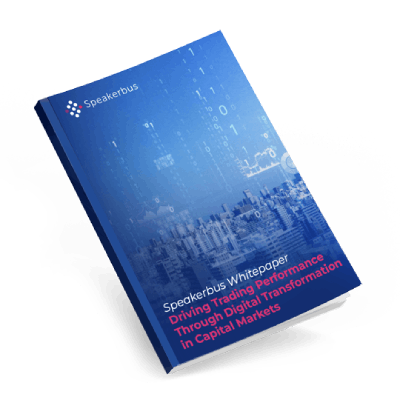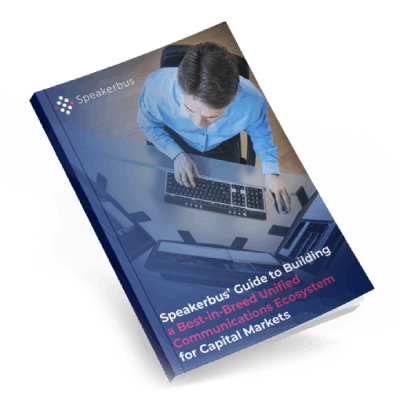INTRODUCTION
Institutional trading performance in the Capital Markets is measured every day, in real-time and depends on the ability to communicate and collaborate clearly and quickly at any moment.
When it comes to how companies and their trading teams interact with the markets, customers and colleagues, the pandemic was a game-changer. The actions taken around the world to stop the spread of COVID-19 brought massive changes to how trading professionals worked and communicated.
Office towers with densely populated trading floors where traders sat cheek-by-jowl using high-performance communications platforms and information technologies emptied as home offices, spare bedrooms, kitchen tables or wherever they could find a semi-quiet spot to perform the complex and often frenetic work of financial trading became the new trading floor.
We learned that very few organizations were truly prepared to support a scenario that included prolonged remote trading, but thankfully, the markets collectively and successfully improvised. In the rush to isolate and adapt, the focus on how to continue the everyday workflow, communication and collaboration that make markets run smoothly became one of the signature challenges for market participants both large and small.
We quickly discovered that maintaining the secure and consistent communications and collaboration that underpins successful trading would require new ways of thinking. And while markets continued to function, it became obvious that digital transformation was no longer just a buzzword, but a requirement for survival.

This whitepaper takes you through the state of digital transformation in trading communications and provides you with a guide on lessons learned, best practices, and what the future holds.
"Contents page
\n-
\n
- Preparing for a hybrid future \n
- The state of transformation in Capital Markets \n
- New paradigms at work \n
- The way forward \n
- Obstacles to becoming digital \n
- Making hybrid trading work \n
- The road to hybrid trading collaboration \n
- Modern cloud communications \n
- The cloud advantage \n
- The build-buy conundrum \n
- Accelerate your digital transformation \n
- Moving forward into the cloud with Speakerbus \n

No time to read this guide now?
\nDownload the whitepaper to read later, or read on to discover the state of transformation in Capital Markets
"\n
Preparing for a hybrid future
\nThe global pandemic forced companies in every industry to adapt quickly to drastically different circumstances and the global Capital Markets were no exception. Before COVID-19, 40% of firms had no remote-working provisions and in the tightly regulated world of financial trading, remote work was considered a non-starter.
While the shift to remote working was a success, the future for trading firms that choose hybrid or fully remote will require a strategic approach to enable operations while balancing the demands of the workforce, as well as remaining compliant with regulatory obligations. These plans must address the perennial industry-specific challenges associated with security, compliance and delivering the superior, consistent user experience that trading teams require, and finally, the residual organisational inertia within their firms.
\n
The state of transformation in Capital Markets
\nDigital innovation is nothing new in Capital Markets. The industry has historically been enthusiastic in its embrace of new technologies to drive both innovation and operating efficiency where and when possible, but certain asset classes, processes and applications have lagged behind. One of these areas is voice trading communications, where the adoption of cloud and digital communications technologies was still in the early adopter phase when COVID-19 struck.
Where IT investment has been a source of competitive advantage and improved profitability for trading businesses in many areas, decades of technology debt has accumulated in their voice communications tech stacks as a result of siloed strategies, budgets and architectures. The urgent need for change is evident in a recent Accenture survey where 37% of executives cited a lack of system integration or compatibility as a top-three obstacle to achieving desired results from technology investments.
The call to action is amplified by the ever-increasing security threats, shifting regulatory compliance landscape and shrinking profit margins that the entire industry is facing.
This is why boardrooms and C-suites around the world have issued clear mandates to drive digital transformation initiatives across their organisations.
Key challenges include:
-
\n
- Reducing excessive complexity and modernising legacy architectures \n
- Upskilling the IT workforce and providing new tools to manage the environment \n
- Delivering secure, scalable and easy-to-use platforms and tools for users \n
Making every connection worth more
With Speakerbus you will be able to lorem ipsum dolor sit amet nunquam
Making every connection worth more
With Speakerbus you will be able to lorem ipsum dolor sit amet nunquam
New paradigms at work
The challenges with modernising legacy tech stacks and practices are just one part of the equation. Companies in every industry are wrestling with the rapid evolution in working practices and expectations of employees when it comes to where they work.
In the Capital Markets sector, 69% of executives in Financial Services firms report that their employees were as productive at home as before the global pandemic and just 11% of staff expect to go back to working full-time in the office. This means that companies will have a continuing need to support remote work and this has accelerated the demand for long-term solutions for digital technologies that help to provide a flexible employee experience, irrespective of where they work, and that can ensure performance, efficiency and compliance in a flexible working world.
Managing these trends in the long term requires a new approach as adding new systems on top of existing workflows could create more problems than they solve, increasing operational complexity, costs and confusion.
The way forward
The remote work experiment demonstrated three keys to success; establish clear and consistent policies for staff; eliminate manual processes through automation wherever possible; and build a communications technology stack that delivers a consistent, high-quality user experience and is accessible from anywhere.
The objective is to empower employees from wherever they are working, optimising performance and satisfaction while reducing the friction associated with remote working and distributed teams.
Key issues include:-
Meeting the expectations of a post-pandemic workforce
-
Maximising productivity and performance for distributed teams
-
Minimising enterprise risk around security and compliance
Obstacles to becoming digital
Research by Accenture revealed the primary challenges facing financial organisations looking to digitally transform their processes were:
-
Lack of change management expertise (40%)
-
Lack of system integration and compatibility (37%)
-
Regulation and compliance changes (37%)
-
Lack of support from staff (30%)
This blend of people and technology issues is a formidable barrier to achieving successful outcomes with any digital transformation initiative.
The scope of overhauling legacy systems across the Capital Markets industry is compounded by switching costs, downtime risk, and the time and effort needed to train and support the workforce on any new solution.
With that in mind, firms must start fresh with a vision of the new workplace and how it can enable a hybrid workforce and advance the business beyond the current state to create a competitive advantage.
Making hybrid trading work
While remote working has been steadily gaining ground in many industries, Financial Services presents unique challenges for remote and virtual working. In addition to the real-time nature of trading, collaboration with colleagues and communications with clients and counterparties is extremely dynamic. Moreover, the industry has a strong bias towards in-office working. A recent PwC Remote Work Survey found that 68% of employers believe employees should be at their desks at least three days per week. Meanwhile, meQuilibrium research on the impact of the pandemic on workforce resilience revealed that Financial Services workers reported the second-highest level of job stress and sleep disorders during mandatory lockdowns, and employee motivation dropped by 32%.
A large part of this rests on the precise nature of financial trading and the demands placed on their teams and leaders. Let’s look at some key factors:
While many industries have had a seamless transition to using virtual collaboration tools, such as Slack, Zoom or Teams, the unique demands of financial trading and the communications that go with it in a highly regulated industry require a specialised approach.
So, defining and implementing an architecture that meets the communications performance and compliance thresholds for trading is critical to building a successful hybrid trading organization.
More than ever before, as trading communications become a multi-platform, multi-channel experience, the solutions deployed must be normalized and integrated with the overall IT, collaboration and compliance environment at each firm.
The road to hybrid trading collaboration
Modern cloud communications
Firms are increasingly including the cloud in their trading communications architecture to support the move to hybrid trading floors. Traders need seamless, secure and compliant communications capabilities that are instant, clear and consistent. IT and compliance must have real-time visibility, management, capture and control of all the communications data.
Firms that make a successful transition to a hybrid trading architecture have the opportunity to deliver a superior client experience and ensure high trading performance under any market conditions.
Cloud-based voice trading communications offer financial firms telephony, intercom, hoot and private wire functionality to enable the immediate connections and instant collaboration that the markets require and are accessible from anywhere their trading teams operate. They also offer the security, compliance and recording functionality that can help to ensure compliance and mitigate risk.
The cloud advantage
Modern cloud communications tools go beyond simply enabling business-as-usual for Capital Market firms. Deployed correctly, these solutions can drive competitive advantage through efficiency, compliance, flexibility and user experience.
Critical advantages for firms that adopt cloud communications tools include:
The build-buy conundrum
The legacy challenge for large businesses is how to integrate new technology efficiently. Historically, new tools have usually been incorporated as add-ons, sitting alongside existing systems and often disconnected from horizontal service provision.
In looking to add solutions that integrate more fully with existing technology, firms have the option to build them in-house. However, this demands significant upfront investment, increasing risk and potential scope creep. One alternative is buying technology through acquisitions, though this can also be costly and lead to the same issues with connectivity, with added lead time.
The most practical option, and one that mitigates the existing challenge of a lack of change management expertise, is to partner with a comprehensive solutions provider that can solve multiple challenges and remove existing single-purpose solutions, resulting in a streamlined network and tech stack. Firms are exploring UCaaS (unified communications as a service) as a cost-efficient solution to transforming trading communications capabilities that are easier to deploy, manage and maintain.
Accelerate your digital transformation
Achieving digital transformation to keep up with the growing demands is a strategic imperative for Capital Markets firms. Those that stay tied to legacy systems and communications tools will be unable to deliver the experience expected from teams, customers and regulators, resulting in higher costs, reduced growth and limited performance.
Firms that can fully embrace the potential of cloud communications tools for traders have the opportunity to create a competitive advantage through improved team engagement, reduced operational expenses and centralised insights across the trading workflow. However, this requires the right tools and the right partner.
Moving forward into the cloud with Speakerbus
Speakerbus is a market leader in creating a tailored and unified cloud communications ecosystem for traders. With over thirty years of experience working with world-leading technology providers to connect teams, systems and channels while ensuring end-to-end compliance, we’ve helped Tier 1 financial institutions leverage cloud software and communications tools to their full potential.
Our expertise goes beyond technology. We work closely with you to understand the key needs of your organisation and match them to targeted solutions that bring your team together with full visibility, security and compliance.
With our comprehensive range of communications solutions for Financial Services, you can enjoy the same security and reliability in and out of the office, with the flexibility to meet today’s demands. We proactively test and update our products to keep up with the latest regulatory requirements and empower firms to trade with confidence, wherever they are.
To find out more about how Speakerbus can empower your team and future-proof your processes, book a demo of our software or get in touch with our team.
" Get in touch.jpg?width=2000&height=1125&name=www.speakerbus.comhubfsUntitled%20design%20(1).jpg)

Or if you’d like to understand more about unified communications solutions and the benefits, download our Guide to Building a Best of Breed Unified Communications Ecosystem for Capital Markets
"

